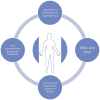EMCREG-International Multidisciplinary Consensus Panel on Management of Hyperkalemia in Chronic Kidney Disease and Heart Failure
- PMID: 39809248
- PMCID: PMC11844669
- DOI: 10.1159/000543385
EMCREG-International Multidisciplinary Consensus Panel on Management of Hyperkalemia in Chronic Kidney Disease and Heart Failure
Abstract
Background: Hyperkalemia, generally defined as serum potassium levels greater than 5.0 mEq/L, poses significant clinical risks, including cardiac toxicity and muscle weakness. Its prevalence and severity increase in patients with chronic kidney disease (CKD), diabetes mellitus, and heart failure (HF), particularly when compounded by medications like angiotensin converting inhibitors, angiotensin receptor blockers, and potassium sparing diuretics. Hyperkalemia arises from disruptions in potassium regulation involving intake, excretion, and intracellular-extracellular distribution. In CKD and acute kidney injury, these regulatory mechanisms are impaired, leading to heightened risk. The management of chronic hyperkalemia presents a challenge due to the necessity of balancing effective cardiovascular and renal therapies against the risk of elevated potassium levels.
Summary: The emergency department management of acute hyperkalemia focuses on preventing cardiac complications through strategies that stabilize cellular membranes and shift potassium intracellularly. Chronic management often involves dietary interventions and pharmacological treatments. Pharmacological management of acute hyperkalemia includes diuretics, which enhance kaliuresis, and potassium binders such as patiromer and sodium zirconium cyclosilicate, which facilitate fecal excretion of potassium. While diuretics are commonly used, they carry risks of volume contraction and renal function deterioration. The newer potassium binders have shown efficacy in lowering chronically elevated potassium levels in CKD and HF patients, offering an alternative to diuretics and other older agents such as sodium polystyrene sulfonate, which has significant adverse effects and limited evidence for chronic use.
Key messages: We convened a consensus panel to describe the optimal management across multiple clinical settings when caring for patients with hyperkalemia. This consensus emphasizes a multidisciplinary approach to managing hyperkalemia, particularly in patients with cardiovascular kidney metabolic syndrome, to avoid fragmentation of care and ensure comprehensive treatment strategies. The primary goal of this manuscript is to describe strategies to maintain cardiovascular benefits of essential medications while effectively managing potassium levels.
Keywords: Chronic kidney disease; Heart failure; Hyperkalemia.
© 2025 The Author(s). Published by S. Karger AG, Basel.
Conflict of interest statement
Dr. Kreitzer received the following NIH grant: K23HD102555 National Institute of Child Health and Human Development, Caregiver Wellness after Traumatic Brain Injury (CG-Well): An Intervention Designed to Promote Well-Being in Caregivers of Acute Moderate to Severe Traumatic Brain Injuries. Dr. Kreitzer is a member of AstraZeneca Andexanet Alfa Speaker Bureau and Independent Neurotrauma Consultant (NFL) and a member of EMCREG-International. Dr. Robert J. Mentz received research support and honoraria from Abbott, Alleviant Medical, American Regent, Amgen, AstraZeneca, Bayer, Boehringer Ingelheim, Boston Scientific, Cytokinetics, Fast BioMedical, Gilead, Innolife, Eli Lilly, Lexicon, Medtronic, Medable, Merck, Novartis, Novo Nordisk, Pfizer, Pharmacosmos, Relypsa, Reprieve Cardiovascular, Respicardia, Roche, Rocket Pharmaceuticals, Sanofi, Verily, Vifor, Windtree Therapeutics, and Zoll. Dr. Fonarow reported receiving personal fees from Abbott Laboratories, Amgen, AstraZeneca, Bayer, Cytokinetics, Edwards, Eli Lilly, Janssen, Medtronic, Merck, Novartis, and Pfizer outside the submitted work. Dr. Gibler was formerly the President of EMCREG-International. Dr. Becker reports receiving support from Ionis as DSMB member, AstraZeneca as DSMB member, Novartis as a DSMB member, and the NIH as a DSMB member and in grant support. He provides Scientific Advisory to Basking Biosciences and Kileie. He also serves as an Up-to-Date author. Dr. Pina reports being on the advisory board with Boehringer Ingelheim. Dr. Amin is a speaker and/or consultant for Pfizer, Salix, Alexion, AstraZeneca, Bayer, Ferring, Seres, Spero, Eli Lilly, Nova Nordisk, Gilead, Renibus, GSK, Dexcom, Reprieve, HeartRite, and AseptiScope. All are outside the scope of the submitted work. Dr. Albert reports being a consultant/advisory board member for AstraZeneca, Boehringer Ingelheim, Lexicon, Merck, and Roche. Dr. Albert has received research grant support from Novartis, AstraZeneca, and Roche that is administered by her workplace. Dr. Kwon is on the AstraZeneca Speaker’s Bureau. She also receives compensation for collaborative work between AstraZeneca and Panoramic Health. She has been an advisory board member for Calliditas and Akebia. She holds stock in Novo Nordisk and Eli Lilly. All other authors have no conflicts of interest to declare.
Figures





References
-
- Bryne N. Hyperkalaemia guideline 2019; 2020.
-
- Howlett JG, Chan M, Ezekowitz JA, Harkness K, Heckman GA, Kouz S, et al. . The Canadian cardiovascular society heart failure companion: bridging guidelines to your practice. Can J Cardiol. 2016;32(3):296–310. - PubMed
-
- International Liaison Committee on Resuscitation . The International Liaison Committee on Resuscitation (ILCOR) consensus on science with treatment recommendations for pediatric and neonatal patients: pediatric basic and advanced life support. Pediatrics. 2006;117(5):e955–77. - PubMed
-
- Nilsson E, Gasparini A, Ärnlöv J, Xu H, Henriksson KM, Coresh J, et al. . Incidence and determinants of hyperkalemia and hypokalemia in a large healthcare system. Int J Cardiol. 2017;245:277–84. - PubMed
Publication types
MeSH terms
Substances
LinkOut - more resources
Full Text Sources
Medical
Research Materials
Miscellaneous

